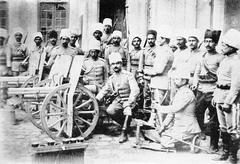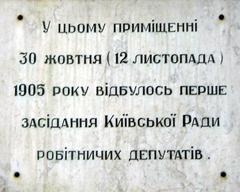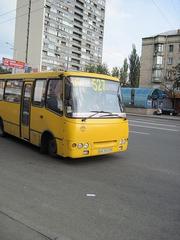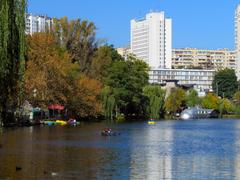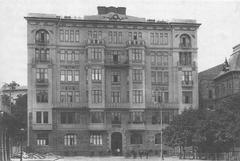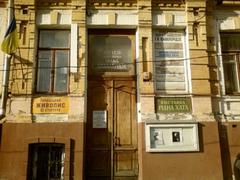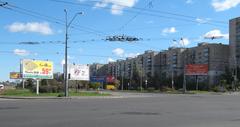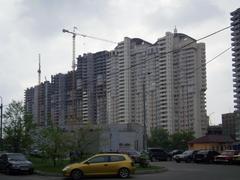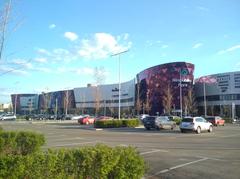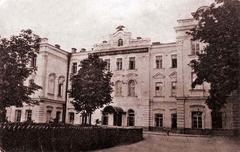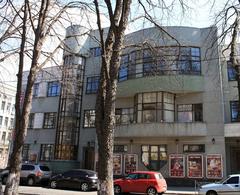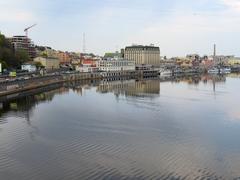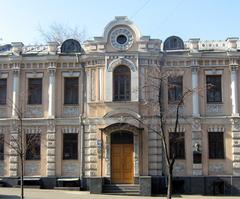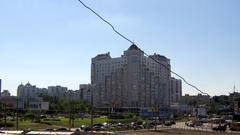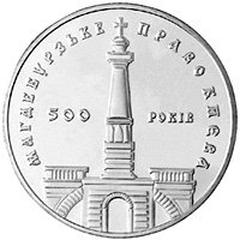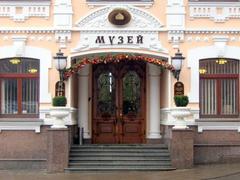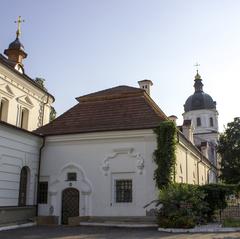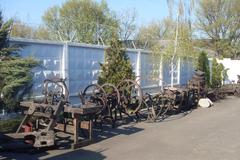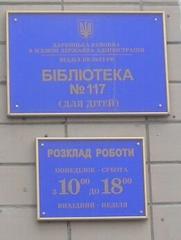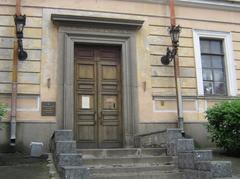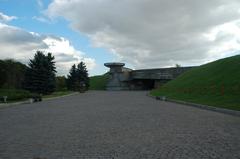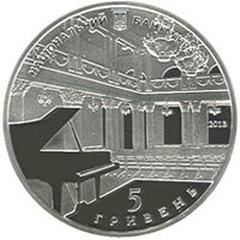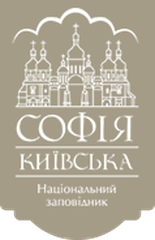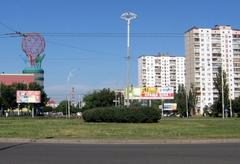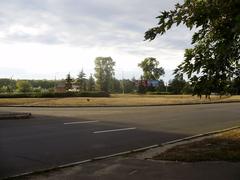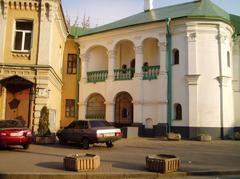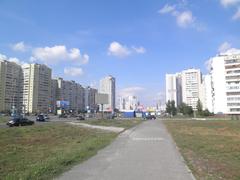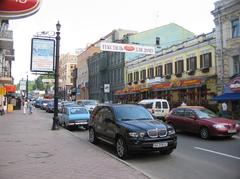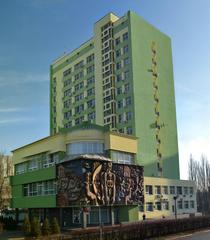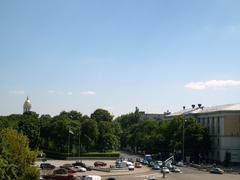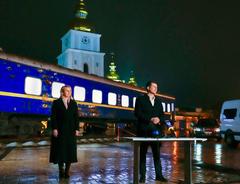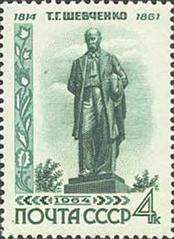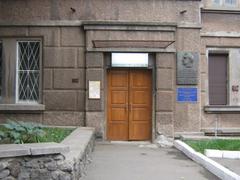Mezheva Street, Kyiv, Ukraine: Comprehensive Visiting Guide
Date: 04/07/2025
Introduction
Mezheva Street (Ukrainian: Межева вулиця), nestled within Kyiv’s historic Podil district, is a vibrant testament to the city’s layered history, cultural resilience, and ongoing urban evolution. Distinct from Kyiv’s grand boulevards, Mezheva Street invites visitors to experience an authentic, pedestrian-friendly artery where residential charm, artisan workshops, and a flourishing contemporary arts scene converge. Its roots date back to the major urban developments of the 18th and 19th centuries, particularly following the great fire of 1811, which transformed Podil from a medieval trade quarter into a structured, modern neighborhood (Britannica).
With its modest neoclassical and eclectic architecture, Mezheva Street is more than a thoroughfare—it’s a living chronicle of Kyiv’s resilience through revolutions, wars, and reinventions. Today, it provides a window into local life and creativity, offering free, year-round access to visitors seeking to immerse themselves in Kyiv’s authentic cultural atmosphere. Close proximity to major landmarks like Andriyivskyy Descent and Kontraktova Square ensures a rich, multifaceted visitor experience (Wanderlog, Kyiv Independent).
Table of Contents
- Early Development and Urban Context
- Historical Significance within Kyiv
- Architectural Evolution
- Mezheva Street in the 20th Century
- Role in Contemporary Kyiv
- Visiting Information: Hours, Tickets, and Accessibility
- Nearby Attractions and Travel Tips
- Visuals and Media
- Notable Events and Residents
- Preservation and Modernization
- Frequently Asked Questions (FAQ)
- Conclusion
- References
Early Development and Urban Context
Podil, among the oldest neighborhoods in Kyiv, boasts archaeological layers dating to the 9th century and the Kyivan Rus era (Britannica). Its riverside location fostered trade and artisan activity for centuries. Mezheva Street emerged during Podil’s reconstruction after the fire of 1811, guided by architect William Heste’s grid plan. This marked the transformation of Podil into an organized urban environment, with Mezheva Street helping define new boundaries and administrative divisions (Kyiv Independent).
Historical Significance within Kyiv
Throughout the 19th century, Mezheva Street was home to merchants, craftsmen, and educators who shaped the economic and cultural landscape of Kyiv (Britannica). Its name—derived from the Ukrainian word for “boundary”—hints at the street’s historic administrative role. The district’s multicultural community included Jewish, Polish, Russian, and Ukrainian residents, contributing to Podil’s cosmopolitan character (World City History).
Architectural Evolution
Mezheva Street showcases a mix of late 19th and early 20th-century architectural styles:
- Neoclassical and Eclectic Residential Buildings: Modest facades, decorative cornices, brickwork, and wrought-iron balconies.
- Soviet-Era Additions: Some buildings were reconfigured or replaced during the Soviet period, reflecting utilitarian design.
- Human Scale: Unlike Kyiv’s monumental boulevards, Mezheva’s narrow corridors and mid-rise buildings foster intimacy and community (Wanderlog).
Mezheva Street in the 20th Century
Podil underwent substantial changes during both the Soviet era and post-independence period.
- Soviet Period: Introduction of communal apartments (kommunalkas), repurposing of buildings for state enterprises, and urban modernization.
- Post-1991 Renewal: Restoration of historic facades, emergence of new businesses, and increased focus on heritage conservation (Wikipedia).
Mezheva Street retained its residential character while adapting to the changing needs of the community.
Role in Contemporary Kyiv
Today, Mezheva Street represents the living heritage of Podil. Its blend of old and new—boutique shops, galleries, artisan studios, and quiet residential blocks—reflects the area’s cultural resurgence. The street’s walkability, proximity to creative spaces, and vibrant local life make it a must-visit for those seeking an off-the-beaten-path Kyiv experience (Wanderlog).
Visiting Information: Hours, Tickets, and Accessibility
- Access: Mezheva Street is a public street, open 24/7 with no entrance fees or tickets required.
- Best Visiting Hours: Daylight hours (9:00 AM–7:00 PM) for architecture, photography, and local businesses.
- Accessibility: The street is pedestrian-friendly. Some older buildings may have limited accessibility, but nearby metro stations (Kontraktova Ploshcha, Poshtova Ploshcha) ensure easy access.
- Local Businesses: Many shops, cafes, and galleries operate between 10:00 AM and 8:00 PM. Special events and markets are common on weekends (MyTravelation).
Nearby Attractions and Travel Tips
- Andriyivskyy Descent: Renowned for its art galleries, craft markets, and vibrant street atmosphere.
- Kontraktova Square: Lively hotspot with cafes, seasonal events, and historic buildings.
- National University of Kyiv-Mohyla Academy: A prestigious educational institution with a storied past.
- Other Landmarks: St. Andrew’s Church, Ukrainian National Chernobyl Museum, Landscape Alley, and artisan markets are within walking distance (Tourspilot, Best Kiev Guide).
- Transportation: Kyiv’s metro, trams, and buses are efficient; ridesharing apps like Uklon and Bolt are widely used (Xplrverse).
Visuals and Media
High-quality images can enrich your exploration:
- Street Views: Mezheva’s neoclassical buildings, mature trees, and daily life (alt: “Mezheva Street neoclassical buildings in Kyiv’s Podil district”).
- Cafés and Shops: Cozy interiors and artisan offerings (alt: “Cozy café on Mezheva Street, Kyiv”).
- Markets and Events: Lively scenes from local markets and festivals.
- Street Art: Vibrant murals reflecting Kyiv’s creative spirit.
For more visuals, visit the Wikimedia Commons gallery.
Notable Events and Residents
While Mezheva Street may not be the site of major historical events, its residents and businesses have contributed to Podil’s intellectual and cultural legacy. The area served as a hub during waves of civic activism, including the Orange Revolution and Euromaidan (World City History). Its proximity to major educational and cultural institutions further enhances its significance.
Preservation and Modernization
Kyiv’s urban planners and local organizations are actively preserving Mezheva Street’s architectural heritage while supporting contemporary needs. Restoration of facades, adaptive reuse of historic structures, and advocacy against overdevelopment help maintain the street’s unique atmosphere (Kyiv Independent, Rubryka).
Frequently Asked Questions (FAQ)
Q: Are there any entrance fees or tickets to visit Mezheva Street?
A: No, Mezheva Street is a public street, accessible free of charge at all times.
Q: What are the best times to visit Mezheva Street?
A: Daylight hours (9:00 AM–7:00 PM) for sightseeing; weekends for markets and events; spring and autumn for pleasant weather.
Q: Is Mezheva Street accessible for people with disabilities?
A: The street is generally pedestrian-friendly, but some older buildings and sidewalks may be less accessible.
Q: What nearby attractions can I visit?
A: Andriyivskyy Descent, Kontraktova Square, St. Andrew’s Church, and the National University of Kyiv-Mohyla Academy.
Q: Are guided tours available?
A: Yes, local operators offer walking tours of Mezheva Street and Podil. Check tourism websites for details (Culture Activities).
Q: Is the area safe for tourists?
A: Podil and Mezheva Street are considered safe, with robust police presence and community engagement. As always, use standard precautions (Visit Ukraine Today).
Conclusion
Mezheva Street stands as a microcosm of Kyiv’s enduring spirit—a place where the city’s storied past, artistic present, and community-focused future intersect. Its walkable, welcoming environment offers visitors a meaningful alternative to busier tourist destinations, allowing for an immersive journey into the heart of Ukrainian urban culture.
To enhance your visit, download the Audiala app for curated audio tours, stay tuned to official Kyiv tourism channels, and support local businesses and artisans during your stay. Embrace the authentic charm of Mezheva Street and let it become a highlight of your Kyiv experience.
References
- Kyiv, History, Britannica
- Kyiv Not Kiev: How Ukrainians Reclaimed Their Capital and Their Future, Kyiv Independent
- Evolution of the Modern City, Kyiv, Britannica
- Most Historic Buildings and Sites in Kyiv, Wanderlog
- History of Ukraine, Wikipedia
- The Fascinating History of Kyiv, Ukraine, World City History
- How Old is Kyiv Really? Shocking Look at the Past, RBC Ukraine
- Kyiv Genplan and Traffic Issues, Rubryka
- Kyiv Experiences, Culture Activities
- Is Kyiv Safe Now? Visit Ukraine Today
- How Safe is it to Travel to Kyiv, Ukraine? Honest Assessment, Xplrverse
- Nomadic Matt Ukraine Travel Tips
- Kyiv Official Tourism Website
- National University of Kyiv-Mohyla Academy
For additional visuals, visit the Wikimedia Commons gallery.
